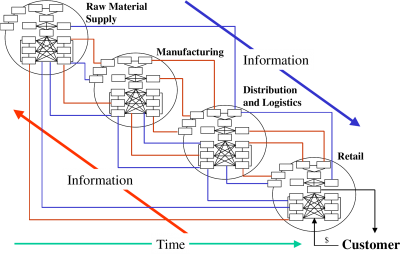...an Innovative Approach to Managing Uncertainty
 Innovations in information technology have enabled companies to adopt supply chain management as a critical element of their corporate strategies. Despite these breakthroughs, many companies have not fully realized the benefits of constructing collaborative relationships with supply chain partners.
Innovations in information technology have enabled companies to adopt supply chain management as a critical element of their corporate strategies. Despite these breakthroughs, many companies have not fully realized the benefits of constructing collaborative relationships with supply chain partners.Professor Jack Muckstadt of Cornell University and his colleagues Drs. Murray, Rappold and Collins point out that, as companies focus on their core competencies, they have made significant strides to integrate their internal business processes and information flows and are leveraging this capability to compete as part of a larger supply chain. This compels corporate leadership to better understand their customers’ needs:
- What do they want?
- Where do they want it?
- When do they want it?
- How do they want to receive it?
- What are they willing to pay for our products and services?
Constructing and operating a competitive supply chain is the primary objective of supply chain management. Several obstacles must be overcome to achieve this goal:
- Demand uncertainty is substantial and it can severely degrade anticipated performance in terms of unit cost, speed, quality, and responsiveness.
- Long and variable response times due to the supply chain’s inability to respond to environmental changes in a timely manner.
- Poor information infrastructures still lack the capabilities necessary to acquire, store, manipulate, and transmit data effectively and quickly.
- Business processes are often not designed properly. Internal and external processes are required to adapt to evolving business and supply chain conditions.
- Inadequately designed business metrics and decision support systems to contend with supply chain uncertainty.
Strategic and tactical modeling paradigms employed in supply chain decision support systems are insufficient. The manner in which uncertainty is treated in many operational environments is inadequate.
The Essential Foundation: Integrated Business Systems
It is essential to think of the supply chain in terms of five interconnected business systems: engineering systems, marketing systems, manufacturing systems, logistics systems, and management systems. Opportunities for supply chain efficiency tend to occur at the boundaries of these individual functions. The greatest competitive advantage comes to those companies that focus on both (1) integrating these five systems intra-organizationally, and (2) integrating these business functions as much as possible with their collaborating supply chain partners.
Supply Chain Operational Excellence: The Five Principles
A competitive advantage will exist only if several key attributes exist in a supply chain. Five guiding principles are necessary for effective supply chains. Applying all Five Principles of Supply Chain Management is necessary for the effective design and execution of supply chain systems:
- Know the Customer.
- Adopt Lean Philosophies.
- Create a Supply Chain Information Infrastructure.
- Integrate Business Processes.
- Unify Decision Support Systems.
1. Know the Customer
Without a clear understanding and definition of customer requirements, a supply chain cannot be effectively constructed. One must construct an information infrastructure to capture customer transaction data, store the data, and analyze it from an operational perspective. The objective is to obtain a clear statement of the customer’s requirements. A supply chain’s requirements vary by customer, product, and location. These requirements must be thoroughly understood and form the foundation for constructing an efficient and effective supply chain.
2. Adopt Lean Philosophies
For the past 25 years operationally excellent companies have focused on creating lean organizations. These companies have shortened internal lead times and made them more predictable and repeatable. They reduced work-in-process inventories from months of supply to days. Firms implemented just-in-time delivery strategies for their most costly component materials, and have worked to dramatically reduce setup times. These actions have substantially reduced indirect costs and improved use of physical space. More importantly, they have created cross-trained, empowered and more highly motivated workers. For maximum supply chain efficiency, all partners must engineer, align, and execute their processes so that the entire chain has the above attributes. Lean supply chains must also be designed as tightly-coupled systems that quickly and profitably respond to market demand fluctuations. No combination of software systems can compensate for a poor physical operating environment. Therefore, lean philosophies must be extended beyond a company’s internal operations to its trading partners across the entire supply chain.
3. Create a Supply Chain Information Infrastructure
An effective information infrastructure, both intra- and inter-organizationally, is necessary for a supply chain to achieve competitive advantage. Today, internet enabled B2B collaboration makes it much easier for supply chain partners to share timely demand information, inventory status, daily capacity usage requirements, evolving marketing plans, product and process design changes, and logistics requirements — to mention just a few. However, true collaboration requires joint planning of inventory and production strategies and the reliable joint execution of operational plans on a continuing basis. How capacity is used daily must be considered from an overall system perspective, not just a local viewpoint. Simply passing data (even customer demand data) among partners does not realize the true economic potential of collaboration.
A traditional collaborative planning and forecasting initiative is merely a starting point; it barely scratches the surface of the financial rewards and competitive advantages that are possible through a true collaborative supply chain. Our recommendation is much more substantive and comprehensive.

4. Integrate Business Processes
Business processes must be established both intra- and inter-organizationally to support the supply chain’s strategic objectives, as illustrated in Figure 1, above. These processes, coupled with the information infrastructure, support the efficient flow of material through the supply chain. While much attention has been placed on understanding business processes within organizations, it is essential to build processes inter-organizationally to leverage and enhance partners’ capabilities. These inter-organizational processes must be designed to take advantage of the increased information that drives daily supply chain decisions.
5. Unify Decision Support Systems
Academics and software providers have designed and built Decision Support System (DSS) environments for individual companies and supply chains. These environments are based on different philosophical models. Also, they differ in how they forecast demand, and how they drive production and allocation decisions. Their goal is to generate plans that simultaneously consider all elements of the supply chain. No matter which approach is taken, these systems and their embedded rules drive many daily supply chain activities. Therefore, they have a substantial impact on the operating behavior, and consequently, on overall supply chain performance. How much they enhance this performance depends on both the accuracy of their input data and the modeling approaches employed. These decision support systems need to address uncertainty in an explicit manner—and most do not.
A New Decision Modeling Paradigm
Commercially available Advanced Planning and Scheduling (APS) systems have led to considerable improvements in supply chain efficiency in many companies. Success in implementing these systems depends on the extent to which the Five Principles of Supply Chain Management are followed. Strategic and tactical modeling paradigms employed in supply chain decision support systems are inadequate. Supply chain manufacturing and distribution systems are often not appropriately designed and operated.
Typical consequences of poor design are inventories concentrated in the wrong products at the wrong locations, and production metrics that do not match projections or meet management’s performance expectations. A fundamental cause of this failure is the environment’s uncertainty and the inability to construct accurate demand forecasts for most items. Given that creating accurate forecasts is difficult, entirely new paradigms like the No B/C Strategy must be used to ensure responsiveness. An integrated supply chain needs to be created that quickly and repeatedly moves the right quantities of materials to customers for those items that experience highly uncertain demand.
A New Operating Philosophy: The No B/C Strategy
When considering how much inventory to carry and in which products, it is essential that inventory be carried in those items for which it will be most useful. Inventory held centrally by manufacturing is nothing more than stored production capacity, or stored time. Most companies have significant inventory write-downs each year, and have to sell off inventory at less than cost. This occurs because it is virtually impossible to predict customer demand over a short lead-time.
So why are companies generating forecasts that are so prone to error? Inventory fundamentally exists in supply chain systems because customer order lead-times are shorter than manufacturing and delivery lead-times. If companies have long lead-times, then they must stock some inventory. This is where traditional planning systems fall short.
When considering the attributes of a new planning paradigm, the planning philosophies must include uncertain demand, customer lead-time requirements, finite production capacity, and inventory stocking decisions for different products and different customers. Not all products and customers behave identically. Not all customers for the same product behave identically, either.
The answer is a hybrid make-to-stock and make-to-order planning strategy that stores inventory in products while considering finite production capacity and highly uncertain demand. Called the No B/C Strategy, it categorizes products into ABC categories using a new method. Inventories exist only for products where there is a low risk of not selling them quickly.
Conclusion
Installing advanced information systems and streamlining business processes will not overcome a poorly designed physical operating environment, and vice versa. Business processes and rules must be tailored to the specific nature of the operating environments and to the supply chain’s objectives. Finally, decision support systems and business processes must be capable of explicitly dealing with uncertainty. One such approach is to employ the No B/C Strategy.
A client company applied all five of the Five Principles and realized a 60% decrease in finished goods inventory for its top 10 products. Concurrently, finished goods stock levels dropped 40% across the product family. Simultaneously, customer service levels (on-time delivery) increased to 95.2%. Most notably, the on-time delivery performance for make-to-order products increased from 37% to 60%, and is still increasing to this day.
Companies with sophisticated and complex supply chains that are willing to embrace change can gain a great competitive advantage. Looking at their supply chain operating paradigm in an innovative way can positively impact bottom line results. By adopting a new operating philosophy, the No B/C Strategy, and adhering to the Five Principles of Supply Chain Management, these companies will see new supply chain efficiencies that previously have not been possible.
This article was adapted, with permission, from Guidelines for Collaborative Supply Chain System Design and Operation; Muckstadt, Murray, Rappold and Collins; Technical Report No. 1286, School of Operations Research and Industrial Engineering, College of Engineering, Cornell University, 2001.
For more information about Supply Chain Leadership, or to attend one of Professor Jack Muckstadt’s courses, visit Excellence in Supply Chain Design + Operation or contact Jim Wynne, Merit Career Development, at jwynne@meritcd.com.
 It can be one of the most uncomfortable situations a project manager faces: You have a team member who simply isn’t delivering. Their work may be late or poor. They skip meetings or don’t file their progress reports in a timely manner. For whatever the reason, their role in the effort hasn’t gelled, and the gap is causing everyone else to scramble.
It can be one of the most uncomfortable situations a project manager faces: You have a team member who simply isn’t delivering. Their work may be late or poor. They skip meetings or don’t file their progress reports in a timely manner. For whatever the reason, their role in the effort hasn’t gelled, and the gap is causing everyone else to scramble. Project managers have to be expert negotiators, able to forge agreements between people who often have competing agendas. For example, the sales team may be determined to speed up a project so that it launches before the holiday shopping season, while Product Development wants to delay long enough to include a hot new feature. Meanwhile, the development team warns that a change in either schedule or scope will wreak havoc on the work they’ve already done. Whatever the dynamics, the project manager has to labor between parties to develop an acceptable solution.
Project managers have to be expert negotiators, able to forge agreements between people who often have competing agendas. For example, the sales team may be determined to speed up a project so that it launches before the holiday shopping season, while Product Development wants to delay long enough to include a hot new feature. Meanwhile, the development team warns that a change in either schedule or scope will wreak havoc on the work they’ve already done. Whatever the dynamics, the project manager has to labor between parties to develop an acceptable solution. Experienced project managers know that their work is about more than scheduling, assigning tasks, and tracking progress. While ultimately their job is to deliver on time and on budget, getting to the finish line often involves challenges that can’t be predicted and whose answers aren’t obvious. Good project managers are in the thick of things, analyzing the issues their teams face and leading in the development of their solutions.
Experienced project managers know that their work is about more than scheduling, assigning tasks, and tracking progress. While ultimately their job is to deliver on time and on budget, getting to the finish line often involves challenges that can’t be predicted and whose answers aren’t obvious. Good project managers are in the thick of things, analyzing the issues their teams face and leading in the development of their solutions. Technology has its roots in everything we do, from our weekdays at the office to our evening and weekend night activities.
Technology has its roots in everything we do, from our weekdays at the office to our evening and weekend night activities. CPAs devote their services to helping clients with complicated accounting and tax needs. It is a revered profession and expertise must extend beyond numbers—the subjective and intimate elements behind this type of advice increase the potential for problems.
CPAs devote their services to helping clients with complicated accounting and tax needs. It is a revered profession and expertise must extend beyond numbers—the subjective and intimate elements behind this type of advice increase the potential for problems. Before the Internet age, working remotely was akin to “playing hooky.” Managers were uncomfortable not being able to see employees, and everything was about face-to-face. But with changes in the global business environment, and the need to find talent wherever it is geographically, the number of people working beyond the office walls has grown. So have the challenges of managing today’s workforce.
Before the Internet age, working remotely was akin to “playing hooky.” Managers were uncomfortable not being able to see employees, and everything was about face-to-face. But with changes in the global business environment, and the need to find talent wherever it is geographically, the number of people working beyond the office walls has grown. So have the challenges of managing today’s workforce. In an ever-changing business environment, leaders need to be nimble, scanning the horizon for opportunities, adjusting their strategy, and involving employees in the process.
In an ever-changing business environment, leaders need to be nimble, scanning the horizon for opportunities, adjusting their strategy, and involving employees in the process. "Business Ethics” is a dangerously murky term with real and profound effects. Ethics are a vital part of every decision, not just hiring practices and the handling of corporate resources.
"Business Ethics” is a dangerously murky term with real and profound effects. Ethics are a vital part of every decision, not just hiring practices and the handling of corporate resources. In order to get the most out of your training investment, project managers should use fun, engaging teaching methods that employ interactivity. Here are four examples of training techniques that help teams learn better.
In order to get the most out of your training investment, project managers should use fun, engaging teaching methods that employ interactivity. Here are four examples of training techniques that help teams learn better.